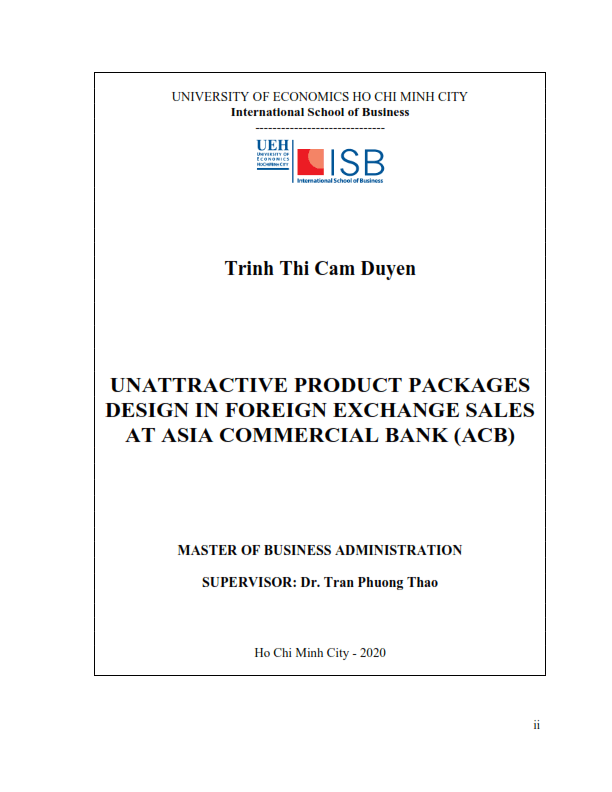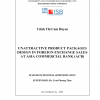Download Luận văn thạc sĩ ngành Quản trị kinh doanh: Unattractive product packages design in foreign exchange sales at Asia Commercial Bank (ACB) (ThS08.066)
In banking or other financial sectors, the attraction of products to customers is one of the most important issues affecting the survival of that business. In the context of the current open economy, if a bank has products that cannot compete with rivals from inside and outside Vietnam, there will be no customers to trust their products and no market for them to develop anymore.
Therefore, the purpose of this thesis is to find the main issues leading to the failure to meet the targets of Foreign exchange (Fx) sales at Asian Commercial Bank (ACB) and thereby to solve this problem. ACB is one of the biggest banks with good reputation in the banking industry today. With the long-term orientation of becoming one of the four largest banks in Vietnam, failure to meet the set targets may contain causes that can affect their goals.
Therefore, at the beginning of 2020, their customer strategy is to find and quickly overcome this potential problem. On the one hand, it will increase the quality of customer service, helping customers to have high effective financial plans to increase production and business, indirectly promote the development of the economy.
On the other hand, it will help to enhance ACB’s position in the eyes of customers and achieve their core values. The main problem is identified based on bank’s data and process analysis, empirical analysis from interviews with stakeholders and association with literature to avoid omission of important possible problem. From the above analysis, unattractive product packages design is identified as the main problem caused the failure of Fx sales’ targets at ACB.
ThS08.066_Unattractive product packages design in foreign exchange sales at Asia Commercial Bank (ACB)
TABLE OF CONTENTS
LIST OF CHARTS........................................................................................................................ vi LIST OF FIGURES....................................................................................................................... vi LIST OF TABLES......................................................................................................................... vi LIST OF ABBREVIATIONS ...................................................................................................... vii EXECUTIVE SUMMARY ......................................................................................................... viii
1. PROBLEM CONTEXT ............................................................................................................. 1
1.1 Company background ............................................................................................................. 1
1.2 Symptoms ............................................................................................................................... 4
1.2.1 Not meet FX sales revenue target..................................................................................... 4
1.2.2 Low profit margin gap...................................................................................................... 5
1.2.3 Poor FX sales trading volumes......................................................................................... 6
2. PROBLEM ANALYSIS............................................................................................................. 6
2.1 Possible problems ................................................................................................................... 6
2.1.1 Uncompetitive FX rate ..................................................................................................... 7
2.1.2 Inappropriate internal policy in FX sales ......................................................................... 9
iii
2.1.3 Unattractive product design............................................................................................ 13
2.1.4 Poor sales performance .................................................................................................. 16
2.2 Main problem validation....................................................................................................... 18
2.3. Problem definition and consequence ................................................................................... 21
2.3.1 Problem definition.......................................................................................................... 21
2.3.2 Consequences ................................................................................................................. 22
3. MAIN CAUSE VALIDATION ............................................................................................... 23
3.1. Possible causes:.................................................................................................................... 23
3.1.1 Poor cooperation among functions:................................................................................ 24
3.1.2 Lack of product management: ........................................................................................ 25
3.1.3 Poor understanding on customer needs: ......................................................................... 27
3.2 Main cause validation: .......................................................................................................... 29
4. SOLUTION SUGGESTION.................................................................................................... 30
4.1. Alternative solutions and justification ................................................................................. 30
4.1.1. Using conjoint analysis to design financial services ..................................................... 31
4.1.2. Hiring a professional market research team .................................................................. 34
iv
4.2 Solution selection.................................................................................................................. 36
4.3 Action plan in organization:.................................................................................................. 37
5. SUPPORTING INFORMATION ........................................................................................... 40
5.1 Summary of research method ............................................................................................... 40
5.2 Interview scripts.................................................................................................................... 41
APPENDIX 1 ................................................................................................................................ 51
REFERENCES ............................................................................................................................. 60
v
LIST OF CHARTS
Chart 1: Share by sales volume P.2
Chart 2: Share by profit P.2
Chart 3: Organization structure P.3
Chart 4: FX sales approval process P.12
Chart 5: ACB approval process for promotion program P.26
LIST OF FIGURES
Figure 1: Initial map P.18
Figure 2: The final causes - effect map P.24
Figure 3: Causes - effect tree P.29
LIST OF TABLES
Tables 1: Forex trading profits P.4
Tables 2: Profit growth rate of forex trading P.5
Table 3: Profit margin per USD P.5
Table 4: Forex trading sales volumes per customer P.6
Table 5: Head of branch’s authorities to lower exchange rates for corporate
customers who have bought or sold foreign currency for more than six months P.11
Table 6: Head of branch’s authorities to lower exchange rates for corporate
customers who have bought or sold foreign currency for more than a year P.11
Table 7: Preferential rates for individual customers who have bought or sold
foreign currency for more than six months P.12
Table 8: Number of companies submitted for headquarters exception P.13
Table 9: International payment fees P.17
vi
LIST OF ABBREVIATIONS
ACB: Asian Commercial Bank
FX: Foreign exchange
KPI: Key performance indicator HCM1: Ho Chi Minh 1 region HCM2: Ho Chi Minh 2 region
HCM3: Ho Chi Minh 3 region
vii
EXECUTIVE SUMMARY
In banking or other financial sectors, the attraction of products to customers is one of the most important issues affecting the survival of that business. In the context of the current open economy, if a bank has products that cannot compete with rivals from inside and outside Vietnam, there will be no customers to trust their products and no market for them to develop anymore. Therefore, the purpose of this thesis is to find the main issues leading to the failure to meet the targets of Foreign exchange (Fx) sales at Asian Commercial Bank (ACB) and thereby to solve this problem. ACB is one of the biggest banks with good reputation in the banking industry today. With the long-term orientation of becoming one of the four largest banks in Vietnam, failure to meet the set targets may contain causes that can affect their goals. Therefore, at the beginning of 2020, their customer strategy is to find and quickly overcome this potential problem. On the one hand, it will increase the quality of customer service, helping customers to have high effective financial plans to increase production and business, indirectly promote the development of the economy. On the other hand, it will help to enhance ACB's position in the eyes of customers and achieve their core values. The main problem is identified based on bank’s data and process analysis, empirical analysis from interviews with stakeholders and association with literature to avoid omission of important possible problem. From the above analysis, unattractive product packages design is identified as the main problem caused the failure of Fx sales'
targets at ACB.
viii
1. PROBLEM CONTEXT
1.1 Company background
Asia Commercial Joint Stock Bank (ACB), one of the five biggest private joint stock commercial banks in Vietnam, has established in 1993. The Bank had 357 branches and sub-branches nation-wide and 10,000 employees. The whole banking system is divided into eight geographical areas, including: Ha Noi City, Northeast, Mekong delta, Red river delta, Southeast, Ho Chi Minh City, South central coast, Highlands. Ho Chi Minh City area is further divided into three areas: Ho Chi Minh 1 (HCM1), Ho Chi Minh 2 (HCM2) and Ho Chi Minh 3 (HCM3). In which, HCM1 includes the branch offices and affiliates located in the center of the city, HCM2 includes units located to the west and HCM3 including units located to the east.
Foreign exchange (Fx) sales of the bank accounts for 2% of the total market share in Vietnam. Their products are Spot, Forward, Swap and CCS for more than 20 popular currencies in the world.
FX sales department belongs to Finance market division that could be known as Treasury division of the bank. Their main functions are to manage and promote the sale of foreign exchange products at distribution channels.
HCM city is the most important key areas that are focused on the bank's development. They have contributed about two-thirds of the total foreign exchange sales volume and profit of the whole ACB banking system as shown in two below charts:
I
Chart 1: Share by sales volume
Chart 2: Share by profit
2
Chart 3: Organization structure
3
1.2 Symptoms
1.2.1 Not meet FX sales revenue target
In the year 2019, the Region 2 of ACB (HCM2) could not meet their profit target in the Foreign exchange sales segment. While the two remaining areas in Ho Chi Minh city still achieved their target (Table 1).
Table 1: Forex trading profits
PROFIT (MILLION VND)
Y2017 Y2018 Y2019
AREA
Profit Target
Com
-pletion rate
Profit Target
Com
-pletion rate
Profit Target
Com
-pletion rate
HCM_1 27,900 29,253 95% 33,315 35,447 94% 50,083 43,176 116% HCM_2 37,755 41,581 91% 44,409 47,736 93% 53,465 56,733 94% HCM_3 42,607 45,866 93% 53,281 54,187 98% 69,463 69,394 100%
TOTAL 108,261 116,700 93% 131,005 137,370 95% 173,011 169,304 102%
Source: Internal Reports
Through 2017, 2018 and 2019, HCM2 has always been the region with the lowest completion rate in HCM city. By the end of 2019, HCM2 is one of the only two areas that have not fulfilled the foreign exchange sales target out of 10 regions in the whole system.
The HCM2 area ranks second in terms of size among the three areas in HCM city but has the lowest growth rate over the years. Over the course of 2020, the decision of the bank's management considers that units in Region 2 need to make more progress than previous years to achieve growth rate to keep up with the remaining two regions that is increase
34% compared to the number made in 2019 (Table 2).
4
Table 2: Profit growth rate of forex trading
PROFIT GROWTH RATE
Y2018 Y2019 Y2020
AREA
Growth rate target
Real growth rate
Growth rate target
Real growth rate
Growth rate target
KV_TPHCM_1 27% 19% 30% 50% 34%
KV_TPHCM_2 26% 18% 28% 20% 34%
KV_TPHCM_3 27% 25% 30% 30% 34%
Source: Internal Reports
This is a big challenge for Region 2, to find the underlying cause and overcome it so that the situation of failing to meet the targets for four consecutive years is no longer happening.
1.2.2 Low profit margin gap
Table 3 has showed that there have been improvements on profit margin over the years from 2017 to 2019, but that of HCM2 still the lowest among the three regions
Table 3: Profit margin per USD
Y2017 Y2018 Y2019
AREA
Profit (Million VND)
Sales volume (Million
USD)
Profit margin per
USD
Profit (Million VND)
Sales volume (Million
USD)
Profit margin per
USD
Profit (Million VND)
Sales volume (Million
USD)
Profit margin per
USD
KV_TPHCM_1 27,900 1,077 26 33,315 1,049 32 50,083 1,258 40
KV_TPHCM_2 37,755 1,545 24 44,409 1,670 27 53,465 1,611 33
KV_TPHCM_3 42,607 1,662 26 53,281 1,986 27 69,463 1,925 36
Source: Internal Reports
5
1.2.3 Poor FX sales trading volumes
As can be seen in Table 4, the average sales of a customer in Region 1 decreased in 2018, then recovered and boomed in 2019. Meanwhile, that of Region 2 has decreased continuously over the years from 2017 to 2019 with the lowest average growth rate. The remaining Region 3 also witnessed a lighter decrease in sales volumes per customer than that of Region 2
Table 4: Forex trading sales volumes per customer
SALES VOLUMES PER CUSTOMER
AREA Y2017 Y2018 Y2019
Average growth rate
KV_TPHCM_1 85,619 72,815 86,293 2% KV_TPHCM_2 98,384 91,451 88,073 -5%
KV_TPHCM_3 81,105 77,737 77,114 -2%
Source: Internal Reports
In the next section, a more thorough analysis of these three symptoms will be conducted.
2. PROBLEM ANALYSIS
2.1 Possible problems
To explore the underlying issues leading to the signs above, the first interview with Mr. Nguyen H. (March 30th 2019) Head of Finance Market Division was conducted with a question on any possible problem of region 2. He said that:
“Region 2 is the area with many large businesses in their customer base, so losing a few large customers is enough to make the business situation of the region worse. The
6
second reason is that the people in charge of this area have discounted their customers so much that the increase in sales cannot compensate”.
The second interview with Mrs. Nguyen V. (March 30th 2019) FX sales specialist in charge of region Ho Chi Minh 2 with the same question to explore more possible problems from the perception of a person in direct contact with distribution channels and customers. In her opinion, she said that:
“The reason for decreasing on revenue is also because there is little competitive advantage on exchange rates. I often hear salesperson and customers reflect very good exchange rates from Vietcombank, HSBC, BIDV, Saccombank, Eximbank, ... sometimes the price that banks offer customers is better than our internal cost of goods sold. This is also a reason to reduce the number of customers and sales of foreign currency segment”
After conducting an interview with two important stakeholders and observing the business activities, an overview of the forex trading situation is summarized into initial cause-effect map. However, it is very messy and requires additional information from primary data, secondary data and literatures to be able to give the answers more accurately and clearly.
2.1.1 Uncompetitive FX rate
“All major currencies now move independently of other currencies, being traded by anyone who wishes. Now, hedge funds, banks, brokerage houses, corporations, and individuals all participate in the foreign exchange market either on a speculative basis, to facilitate transactions, or to hedge against currency risks associated with their core business. Foreign
exchange is a business of exchanging one currency for another” (1). In terms of FX sales,
7
the currency is like the commodity traded and the exchange rate could be understood as the price of the commodity. Therefore, the importance of exchange rate to bank performance is also the influence of price to firm performance. This is one of the generic competitive strategies, in which an appropriate combination of price (cost) and differentiation position of a company is its competitive advantage (2).
Currently on the interbank system, the listed exchange rate of ACB compare to their peers is competitive, sometimes even better than the listed price of state-owned banks. However, for the special customer segment offered preferential rates, the bank even selling at the price lower than their cost of goods sold to entice customers to use bank’s other products and services. ACB often losses large customers for state-owned banks and sometimes small and medium-sized customers for other private commercial banks because of uncompetitive FX rate.
Regarding to the cost of goods sold, it is calculated by the Operations team of the Foreign Exchange department. They use the interbank market price and adding from one to two VND for exchange rate risk, the gap between the cost of goods sold for the branches buying from customers and selling to customers is 5 VND/currency. In addition, it depends on the position of the whole system is negative or positive how much money to decide the price will be more favorable for buying or selling foreign currencies to customers. In order to prevent exchange rate risk, the position of the whole system must not exceed negative or positive $3 million.
Sometimes, in cases that large customers with big amount of foreign currency are offered extremely competitive rates from other banks, ACB needs to have good sources to balance.
8
However, the bank not often have inflow and outflow sources to balance the big amount of selling or buying deals, so they rarely have good prices to retain customers. Examples some deals with large companies, Regina Miracle International Vietnam are companies with foreign direct investment in the apparel and footwear sectors. On September 9th 2019, the company needed to sell $12 million. The market rate at that time was 23,194
VND/USD, ACB bank suffered a loss of 1 point to offer customers for 23,195 VND/USD but they dropped this deal because the company sold to Vietcombank Hai Phong with the much higher exchange rate at 23,199 VND/USD. On October 30th 2019, Vietnam Electric Cable Corporation - Cadivi.VN needed to buy $10 million to pay for the import of raw materials for production. The market rate at the time was 23,239 VND/USD, ACB suffered a loss of 2 points to offer customers for 23,237 VND/USD but the company bought at Vietinbank Dong Nai with the exchange rate at 23,236 VND/USD that even lower the market price. For some deals with a smaller amount of foreign currencies and depending on the system status, sometimes ACB can still close deals with these customers. On November 7th 2019, the Regina company needed to sell $3.9 million. The market rate at that time was 23,230 VND/USD, ACB bank offered customers for 23,233 VND/USD and get the deal. However, these transactions are often non-profit, so it only helps to increase sales and keep relationships with customers, not contribute much in terms of profit.
2.1.2 Inappropriate internal policy in FX sales
There are many types of internal policies within a company: internal control policies, social and environmental policies, internal competition, employee treatment policies, etc. In
overall, these policies have a great influence on the performance of a business (3). Because
9
it creates a favorable working environment for employees and helps them to get the job done in the most efficient way (4).
The decrease in profit margin gap also is due to the inappropriate internal policy in FX sales. In the Foreign exchange sales policy, they have the favorable for new customers or loyal customers bringing big amount of foreign currency sales volume. There is a regulation on the rate of foreign currency discount according to the head of branch’s authorities.
For new corporate customers, customers who have never done foreign currency transactions with the bank, or have stopped trading for more than a year, the highest preferential rate will be applied under the authority of the head of branch offices or affiliates (reduced maximum 90% of the profit margin when buying foreign currencies from customers and 80% of that when selling to customers); after 06 months, the potential value of that customer will be re-evaluated based on the foreign currency sales volume, then apply the preferential rate in Table 5; After one year, the customer would be consider as existing customers of ACB, the foreign exchange transactions with the customers will be re-evaluated again and determine the preferential level for customers as Table 6. This
evaluation will be repeated every year.
10
Table 5: Head of branch’s authorities to lower exchange rates for corporate
customers who have bought or sold foreign currency for more than six months
The previous six month's sale volume
Less than
New Organization customer
More than
3 mil USD
1-3 mil
USD
0.5-1 mil
USD
0.5 mil
USD
Buy from customer 80% 80% 70% 60%
Sell to customer 70% 60% 50% 40%
Source: Internal Policy
Table 6: Head of branch’s authorities to lower exchange rates for corporate customers who have bought or sold foreign currency for more than a year
Recent
The previous year's sale volume
Less than
Organization customer
More than
10 mil USD
5-10 mil
USD
3-5 mil USD
1-3 mil
USD
1 mil
USD
Buy from customer 90% 80% 70% 60%
Sell to customer 80% 70% 60% 50% 40%
Source: Internal Policy
For new individual customers: a maximum reduction of 70% of the profit margin of buying foreign currencies from customers; after six months, they are considered as existing customers. For the existing customers, based on customer membership ratings, there are appropriate preferential rate, but there is no exchange rate reduction for the foreign
currency sold to customers (Table 7).
11
Table 7: Preferential rates for individual customers who have bought or sold foreign
currency for more than six months
Recent Personal
customer
Customer membership
Diamond Gold Titan Silver Copper
Buy from customer 70% 60% 50% 40% 30%
Sell to customer No discount
Source: Internal Policy
When the approval of the head of branch’s authorities are not meet the requirements of the customer and it is needful to apply a higher preferential rate to keep customers, the exception will be submitted to the Foreign Exchange department for further review. The Foreign exchange sales approval process was showed in Chart 4. With a fast and simple procedure, so that the distribution channel does not miss their sales opportunities in the context of rapid change of exchange rates.
Chart 4: FX sales approval process
Customer Salespeople Head of branch
FX sales officer
Source: Internal Policy
By the end of 2019, the number of customers submitted for foreign exchange rate reduction that exceed the authority of the head of branch/sub-branch are showed as below (Table 8):
12















